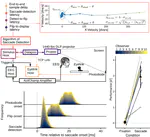gaze-contingent presentation
To study intrasaccadic vision, we need stimulus manipulations that occur strictly during saccades. Due to the brief durations of saccades, this can prove a difficult task, as various system latencies (eye tracker, refresh cycle, video delay, and some more) have to be considered. While most of these delays are hardware-dependent, one opportunity to alleviate timing issues in gaze-contingent eye-tracking paradigms is applying an efficient online saccade detection! In this paper we described such an algorithm, validated it in simulations and experiments, and made it publicly available so that it can be used with a range of different programming languages.
